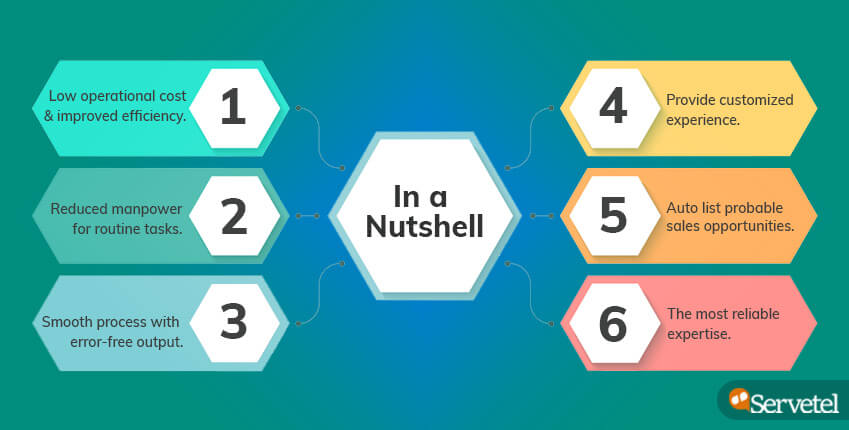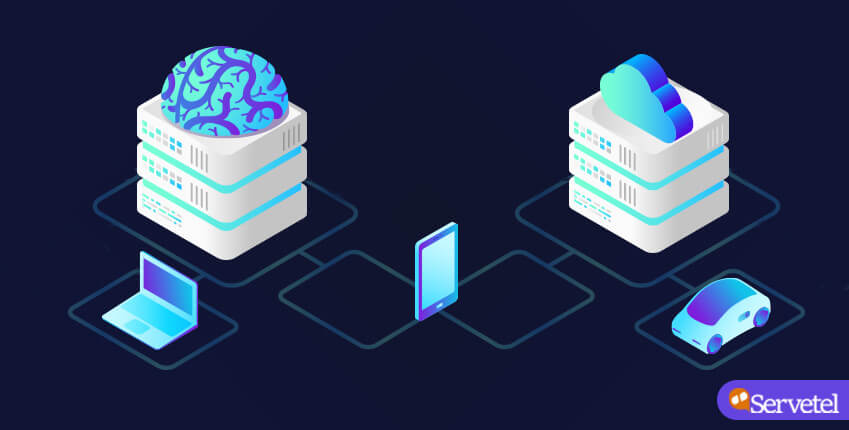Cloud and Artificial Intelligence, the two most Groundbreaking technologies of this day and age, are fast changing the future. So how independent or interdependent are these? And more importantly, what is the significance of this for your organization?
Let’s answer these questions while uncovering a few more implications of these positive disruptions.
What is cloud technology and how it’s changing the present and the future?
The art of using server-based systems for various purposes can be described as cloud technology. The employment of server-based or remote systems has brought upon an immense amount of progress. Cloud technology opened doors to innovations and saw amelioration of existing systems.
As a result of this, organizations are shifting to cloud-based systems from the traditional on-site physical systems. The pace of advancement of cloud technology has seen dramatic changes in organizational competitiveness. Those who fell behind are having a hard time catching up to those who adapted cloud technology at an early stage. This together with the everyday advancement of cloud technology is only adding to the lag faced so far.

So what does cloud technology brings to the table?
Software as a Service (SaaS):
These are the applications that an organization uses without the hassle to manage or maintain them. These applications are managed by the vendors that deliver them.
SaaS applications are delivered through the internet. As a result of this, there is no need to employ IT staff to create and install applications individually on each system. Also, because these are managed by third-party vendors, all technical aspects such as database, servers, and middleware no longer remain a responsibility of the organization. Shall an issue occur with these aspects, the third-party vendor resolves it.
This, SaaS users enjoy the following advantages:
- Significant reduction in time and money spent on the development and maintenance of similar applications.
- Access over the internet due to remote hosting of application.
- Hassle-free hardware or software update done by the third-party vendor at their end.
What to ensure before choosing a SaaS vendor?
Integrability:
It is important to ensure whether the SaaS app can be integrated with the existing applications requiring integration. It must be ensured whether the vendor offers only limited support or complete integration.
Data Security and control:
Since SaaS apps are developed and managed by vendors, the data exchanged via the medium of these apps may become susceptible to vulnerability. Also, immense care must be taken before handing control of data to the vendor.
Feature limitation:
Vendors often provide standard service that may, At times,be a trade-off with performance, security, or other such features.
Performance and downtime:
Due to vendor’s control over development and maintenance, organizations may suffer performance or downtime issues.
With considerable care at the time of choosing the vendor, these problems can be easily prevented.
Google GSuite, Dropbox, and salesforce are a few simple examples of Cloud Software Services frequently used in the industry.
Platform as a Service (PaaS):
PaaS can easily be described as a platform that developers can use to create customized applications. In other words, a platform is delivered, upon which developers can build customized apps. This is a step further from SaaS in the sense that rather than software, a platform is provided, giving developers the liberty to design as they see fit. PaaS provides the underlying operating system, necessary updates, infrastructure, and storage. PaaS may at times, be known as middleware, with high scalability and availability.
Due to this PaaS users enjoy the following benefits:
- Feasible development and maintenance of software, with the vendor-maintained underlying infrastructure.
- Hassle-free, limitless customization of applications.
- Easy scalability of resources based on business needs.
What to ensure before choosing a PaaS vendor?
Data Security and Control:
Although an organization runs its own apps and services, the data is stored at the cloud servers provided by third-party vendors. This may pose some risk.
Operational Restrictions:
Using PaaS operational burden is heavily nullified. But, consequently, operational freedom may be restricted. A simple way to avoid this is to verify the operational capabilities of the PaaS system before finalizing it.
Migration Policy:
It is possible for an organization to abandon the PaaS system in the near or far future. Vendor’s migration policy in such cases may pose a problem, affecting the organization significantly.
Nonetheless, these problems can also be easily prevented by paying considerable care at the time of choosing the vendor.
Windows Azure and Google App Engine are common Cloud Platform Service providers.
Infrastructure as a Service (IaaS):
IaaS employs virtualization technology to provide infrastructural services such as network, servers, storage, and operating system. In other words, total control of infrastructure is provided to an organization. This can be done by providing a dashboard or an API.
The advantage? An organization gets entire control of infrastructure, as if, it was a traditional data centre, without actually hosting an on-premise centre.
The organization is capable of performing all operations without the burden of physically maintaining or managing the technology. This implies that the organization gets to manage and manipulate all the servers, operating systems, storage, and network as they please. They are also able to govern the behavior of their applications, operating systems, middleware, and data.
Due to this, IaaS users enjoy the following benefits:
- The most adaptable cloud service model allowing scalability as per requirement.
- Complete behavioral control of all aspects and infrastructure.
- Employability of multiple users over single hardware.
- Consumption-based pricing.
What to ensure before choosing an IaaS vendor?
Data Security:
So one gets complete control, but the vendor dynamically allocates hardware resources based upon availability. Consequently, there may arise a situation wherein data storage is allotted to a new customer, which was previously occupied by another customer.
If preventive measures are not taken, the data hosted by the previous customer may fall in the hands of the new customer.
Therefore, the vendor should be reliable enough to ensure such mishaps don’t occur.
Google Compute Engine and Amazon Web Service are popular Cloud Infrastructure Service providers.
- What is the significance of this? Like lego blocks, build exactly as you need it. Irrespective of an organization’s size, cloud-technology has something to offer to everyone.
At an early stage, an organization may be keen on focusing manpower on business development. Hence, they can save a lot of time and capital by utilizing dedicated software rather than developing their own. As the business flourishes and demand arises, they can start transitioning from SaaS to PaaS and further to IaaS.
The Most significant advantage here is scalability. An organization can upscale or downscale resources with subsequent fluctuation in requirement. Consequently, one is only billed for what is acquired.
- So is that it? And more importantly, is it a primal requirement to render confidential data at the vendor’s data centre?Well, not really! This is where the Hybrid Cloud comes into play. A hybrid cloud is a combination of a private cloud (on-premise data centre) and a public cloud (remote data centre) made possible by allowing resources to be shared between the two.
Rightly defined by Microsoft Azure as the “best of all possible worlds” platform, hybrid cloud allows organizations to scale their resources to the public cloud when the demand arises. The more sensitive data can be stored at the private cloud, while the less sensitive data can be stored at the public cloud. This means the sensitive information can be kept safely behind a firewall. And, since the two clouds work in synchronization, there is no effect on the performance.
The lowest possible risk of data exposure with the scalability, cost-effectiveness, and computing prowess of the cloud; truly the best of all possible worlds.
What is Artificial Intelligence and how it’s changing the present and the future?
In simplest terms, artificial intelligence can be understood as “the art of making machines capable of doing things, which, at present, humans do better” (or perhaps, did better!)
Artificial Intelligence revolves around the principle that machines can possess human-like cognition, provided a well-formulated structure has been devised to achieve the same. There are three steps involved to achieve this, namely, learning, reasoning, and feedback system (or feedback-driven learning).

Learning:
Learning is the stage when the AI system acquires the information and the rules governing the usage of that information.
Reasoning:
When reasoning, the AI system uses the rules and information in an ‘intelligent’ manner to derive a valid conclusion.
Feedback:
Feedback-driven learning is the art of learning from the mistakes previously made. This is done using a feedback loop.
Simply, an artificially intelligent system can be categorized into two categories. Weak AI and Strong AI.
Weak AI:
Also known as narrow artificial intelligence, a weak AI can perform a predefined task. Although it is capable of generating outputs at a much faster rate than a human, it lacks the cognitive abilities of a human. Google Assistant and Siri are examples of a narrow AI.
Strong AI:
Also known as artificial general intelligence. A strong AI is based on neural networks, much like humans. Because of this, it possesses the general cognitive abilities that a human has. Consequently, when under unfamiliar territories, a strong AI can find a way out without any human intervention.
The onset of artificial intelligence, much like that of computers, saw extreme competence in the corporate realm. Every organization started adopting AI to improve its efficiency and reduce the investment in manpower. After all, AI only needs to be developed once.
An example of intelligent AI is Deep Blue. It defeated then world champion Gary Kasparov in chess, proving that machines can be more intelligent than humans.
Businesses, therefore, started seeking ways to implement as much AI as possible in order to reduce time, investments, and errors. With AI, all one needs to do is provide data, the set of rules, a structure to follow those rules, and some parameters (guidelines to make decisions) to derive the conclusion.
Once this is done, the artificial intelligence system performs the tasks that a human does with those parameters. And within that atmosphere, the AI system will prove to be more efficient (fast and error-free) than most humans. But even the slightest variation in the circumstances made AI unable to deliver the performance so required, something a human will never struggle with.
Consequently, this didn’t seem very intelligent. A human would require much less! And so forth, came Machine Learning.
The goal of machine learning was to automate or realize AI. Further advancements in machine learning paved the way, via which, algorithms could be trained to make decisions on their own. This largely reduced the amount of information required. So now, the data, the set of rules, and the structure to follow the rules sufficed. This allowed businesses to produce a machine-based environment that would require very little human intervention to perform tasks. These machines proved impeccable in performing desired tasks.
An example of this can be seen in the stock market. With the advancement of machine learning, stocks started getting traded online. HFT or High Frequency Trading (where trading started happening in bulk, so even the slightest profit will multiply exponentially) became the next big thing in the stock market.
Other than this, Machine Learning based systems are capable of creating automated technologies such as self-driven cars and drone delivery. The two most paramount changes to be observed in our day-to-day lives in the near future.
These are just a few elaborations of the significance ML has on organizations across all paradigms.
But, as is the case with most technologies, organizations needed more. So, okay, deep blue did defeat Gary Kasparov, but it did so by producing more number of possibilities per second than a human ever could. This also included petty moves that a human will not even consider making. So it is not as smart after all. And the HFT algorithms can render a lot of loss if the market was to fluctuate or crash like the www bubble burst of 2008.
A human can foresee this, but a brute force AI or an ML cannot as they don’t have the neural system that we do. Or at least such was the case! And this led to the introduction of a Neural Network based model known as Deep Learning. The objective of deep learning is to automate or realize Machine Learning. The underlying architecture of deep learning is such that it mimics the human neural system. Consequently, deep learning is so strong that all it needs is the basic rules that apply to a system and can derive the method of achieving the desired goal. The implications of this are huge.
The Deep Learning system Alpha Zero only required the basic moves of games like chess and go. Post that, in order to learn how to play, it played against itself. Sounds human-like? After that, it was able to beat the best human grandmasters with ease. Today, the best of the players use deep learning systems to better their games.
Transformation of various organizational paradigms:
With the advent of deep learning-enabled systems, many organizations are undergoing exuberant changes. Venture capital investment alone is at a staggering $3 billion annually and rising. The following organizational sectors will see the most influence from ArtificiaI Intelligence, Machine Learning, and Deep Learning:
Derive pragmatic intel from large datasets:
Database management systems are now being automated. The need to manage a database manually no longer exists. And the automation of the database has led to the involvement of intelligence-based systems in deriving recommendations and providing insights by analyzing the data. Thus, leading to automated analytics.
This paved the path to automated functionality. Functionality automation is similar to analytics automation with the additional operation of performing an action based on the given recommendation. An example of this would be inventory management (adding stock of items running out or of those high in demand).
Business Management:
Business Management is perhaps the most influenced paradigm of an organization undergoing transformation stemming from the advent of AI and its realizations. This has enabled organizations to filter spams from relevant businesses. It also allows an organization to categorize leads in the order of likeliness of business acquisition possibility. Thus optimizing business development to the fullest. A simple consequence of this can be seen with smart email categorization and deployment.
Voice to text feature has enabled businesses to generate transcripts, personalized emails, invoice et al., without any human intervention. Whereas, text to voice enables businesses to produce personalized voice response by simply using dynamic data; again, without any human intervention.
Smart personal assistants, in coordination with automated responders and automated customer support systems, are being employed by the leading b2c and b2b companies to smoothen customer support.
With forecasted business opportunities and process automation, smart devices are being created that adjust according to requirements. Also, because undesired elements can be filtered, the process of security surveillance can now be automated. The maximum significance of these can be observed in data-driven such as financial services.
E-commerce and intelligent systems:
E-commerce is an industry that will be the first to become completely controlled via intelligent systems. The onset of smart search (an efficient and intuitive automated method that displays results based on customer buying habits) and relevance features (the most relevant article to the keyword) e-commerce platforms are boosting their sales, while still increasing customer satisfaction rates.
This has created a platform where personalization itself has become a service. Based on a customer’s buying habits, e-commerce websites are now capable of predicting purchases that a customer may make, thanks to intelligent systems. Because of this, they are able to recommend products suitable for a particular customer, and also provide some other products that are most likely to be bought, thereby upselling to the same customer,
The next catch in the e-commerce industry is the much-debated ‘dynamic price optimization’. Although it is a reality for many companies today, the morality of using dynamic pricing is still doubted. Should one product really have multiple price tags? Unsure, whether this is a bane or a boon, dynamic pricing, for sure, is in the industry to stay, unless governments across the globe are able to derive a definite conclusion.
And finally, detection and prevention of frauds for online transactions. Yes! this no longer is a huge concern as there most eCommerce businesses have embedded intelligent systems to prevent such mishaps. So shop freely!
The core of every industry- Marketing:
Marketing, just like driving, was once considered outside the scope of machines. The onset of the digital industry, however, saw an entirely different picture. Automated systems have now found application in the very essence of marketing. Be it a recommendation or content curation; customer segmentation or news feed personalization, ad targeting and optimization are becoming automated. This is reforming the art of social semantics together with sentiment analysis.
Now organizations use predictive customer services augmented with automated web designs to deliver a personalized experience to each individual. Pattern and image recognition, together with language recognition, is creating ‘a new world approach’ to digest disorganized data coming from various customers and sales prospects and convert it into relevant information that will help formulate future strategies.
In a Nutshell
What started as the prime resource for gaining an advantage over a competitor, pivoted to become the most important resource ever to be developed in the history of organizational resources. Here is what an organization can achieve by rightly using intelligent systems.

The Merger That Will Reshape The Future
The most prominent enigma in the industry today is that Artificial Intelligence and Cloud Computing are two sides of the same coin. What does this signify? And how much of it is true?
More than just a reduction in capital, cloud computing has become an indispensable asset for the new age artificial intelligence systems and It’s further realized derivatives (machine learning and deep leaning). As per Deloitte’s survey, 49% of AI-backed enterprises today are implementing cloud-based services. One of the most influencing factors for this is the integration of AI-based services in the cloud offerings. Most cloud-based organizations are providing AI service at a very low upfront cost. The low cost, with the reduction of capital on manpower, has seen exponential growth of both AI and cloud computing.
How the Cloud is helping AI
Cloud computing is an integral part of the development and deployment of AI. Even though most organizations know the importance of AI in the business realm, the development and deployment of AI Requires not only a great amount of time and effort but also the expertise and expenditure of multiple best of their class (highly skilled) AI developers.
This decreases the viability of an AI system for most small and medium enterprises. Consequently, even though there is substantial growth in implementing AI, and enterprises may be aware of how to implement it, they do not have the means to afford it.
This is where the cloud comes in. Cloud has three impeccable offerings for organizations willing to implement AI. First and foremost, cloud-based AI implies the availability of tools and research, developed over the years, at an instant. To top it off, the small price tag on AI-based services is getting even smaller day by day.
Secondly, the data set required for optimum performance of AI will not be available, if not for the cloud. As if the case with AI, the more data it operates upon, the better it gets. Because a cloud implemented AI has access to such load of data, the performance of a cloud-integrated AI, by far supersedes that of a locally hosted one.
And lastly, an organization needs to be highly scalable in order to provide this magnitude of data-intensive services to various customers. If not for cloud, such a prospect will be infeasible.
As a result of this, cloud-based giants are introducing competitive offerings of AI to market at an affordable pricing structure.
How AI is helping the Cloud
The prowess of AI is ameliorating cloud computational environments to render organizations strategically advanced, economically efficient, and more insight-driven. Here is what the cloud is gaining from the implementation of AI:
Upgraded Data Management
AI has streamlined the hectic processes of adding, updating, and managing new and old data for an organization, so as to avail accurate real-time data efficiently. The repositories of data that an organization requires is getting bigger day by day, and consequently, the task of managing such data is getting tougher.
The indulgence of AI has seen a major impact on organizational paradigms such as business management, customer data, and supply chain data management.
Banking is a prime example of data management benefitting from AI. Even the smallest of financial organizations need to oversee thousands of transactions a day. Even the simple task of managing the infrastructure- identify data, add to the database, catalog it, manage and repeat for each transaction is very tedious. So much so, that if done manually, will require tens of employees, if not hundreds.
Hence, AI is an integral part of such industries dealing with the large volumes of data flow.
AIaaS, the newest as a service Paradigm
Software as a Sevice saw the latest up-gradation with AI being integrated in the package. SaaS companies are now providing a larger platform, delivering more value by embedding AI. Since SaaS providers only need to implement it once, they can provide it to multiple clients at a fraction of the development cost and still generate exponential revenue.
For end-users, this is a low cost to pay in turn for the benefits (the increment in functionality itself is too exhilarating) they will reap by utilizing such systems.
A simple example of the benefits of AIaaS can be seen in client relationship management systems. AI-enabled CRM can provide a personalized experience to customers based on their past behavior. It also renders tracking customer behavior and relationship easy to manage. All of this significantly enhances the conversion rates of an organization.
AI is rendering Dynamic Cloud Services automated
Based on the previous example, we can see that AIaaS smoothens lead conversion for businesses. This has an impact on how businesses are adopting various tools over the cloud. Based on demand, the usage of one tool or service may increase while that of another may decrease.
In cases as such, cloud service providers are embedding AI to implement dynamic tools and service allocation. The pricing for these allocations is such that a user only pays for what has actually been used, still enjoying the scalability and efficiency of cloud-based systems.
And because the advent of AI renders this process automated, no support assistance is required for scaling (either upscaling or downscaling). As requirements increase, the scalability is managed by the AI system itself. Consequently, the cloud is no more left to be managed by service providers, their AIs do it for them! The pinnacle of any industry, a true win-win situation.
Take-Away; the numbers say it all!
The survey from Statista estimates that by 2025, the AI market will oversee a staggering $118.6 billion annual capital. Whereas, several studies predict an upward growth of cloud computing market in the coming years. The merger of the two signifies that the above estimates are, by far, only an underestimate and not an overestimate.
The future of businesses, undoubtedly, heavily relies upon their efficient adaptation of these technologies. The ones that fall behind will have a hard time coping up. Now is the time to adapt to the AI integrated cloud. For if you don’t change with the times, the times are going to change you.
Ring us at 1800-120-4132 to know more.

















